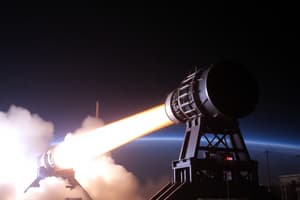Podcast
Questions and Answers
What was the key technological enhancement that allowed Aftershock II to withstand extreme temperatures?
What was the key technological enhancement that allowed Aftershock II to withstand extreme temperatures?
- Improved parachute deployment system.
- Advanced navigation system.
- Lightweight aluminum alloy construction.
- Titanium-coated fins and heat-resistant paint. (correct)
Why is RPL shifting its focus to 'sounding' rockets?
Why is RPL shifting its focus to 'sounding' rockets?
- To obtain funding from scientific organizations.
- To simplify the rocket design process.
- To break their own altitude record again; they are confident they can reach 500,000 feet.
- To carry scientific instruments into space for research, as higher altitude launches require special permissions. (correct)
Approximately how many times faster than the speed of sound did Aftershock II travel?
Approximately how many times faster than the speed of sound did Aftershock II travel?
- 4.5 times the speed of sound.
- 5.5 times the speed of sound. (correct)
- 3.5 times the speed of sound.
- 6.5 times the speed of sound.
What is the Kármán line, and what significance does it hold for RPL?
What is the Kármán line, and what significance does it hold for RPL?
What event occurred approximately 85 seconds after the launch of Aftershock II?
What event occurred approximately 85 seconds after the launch of Aftershock II?
How many feet higher did Aftershock II fly compared to the previous amateur rocket altitude record?
How many feet higher did Aftershock II fly compared to the previous amateur rocket altitude record?
What is the approximate amateur rocketry altitude limit that RPL is mindful of?
What is the approximate amateur rocketry altitude limit that RPL is mindful of?
What specific action did the Aftershock II take 92 seconds after launch?
What specific action did the Aftershock II take 92 seconds after launch?
Flashcards
Aftershock II
Aftershock II
USC Rocket Propulsion Lab's rocket that reached 470,000 feet, breaking a 20-year record.
GoFast Rocket
GoFast Rocket
The previous record holder for amateur rocket altitude, set in 2004 before Aftershock II.
3,600 mph
3,600 mph
The approximate speed of Aftershock II at its fastest point after launch.
Titanium fins and heat-resistant paint
Titanium fins and heat-resistant paint
Signup and view all the flashcards
Student-designed computer systems
Student-designed computer systems
Signup and view all the flashcards
Traveler IV Rocket
Traveler IV Rocket
Signup and view all the flashcards
Kármán Line
Kármán Line
Signup and view all the flashcards
Sounding Rockets
Sounding Rockets
Signup and view all the flashcards
Study Notes
- A rocket named Aftershock II, built by students at the University of Southern California (USC) Rocket Propulsion Lab (RPL), broke a 20-year record.
Aftershock II Launch Details
- Launched on October 20, 2024, from Nevada's Black Rock Desert.
- Reached an altitude of 470,000 feet (143.3 km).
- Broke the previous amateur rocket altitude record of 380,000 feet (115.8 km) set by the Civilian Space eXploration Team's GoFast rocket in 2004 by 90,000 feet (27.4 km).
Aftershock II Speed and Design
- The rocket is 14 feet (4 m) tall
- Broke the sound barrier within two seconds of launch.
- Achieved a maximum speed of 3,600 mph (5,800 km/h), which is 5.5 times the speed of sound, 19 seconds after launch, slightly exceeding GoFast's speed record.
- Continued its ascent after the engine burned out shortly after launch.
- Exited Earth's atmosphere approximately 85 seconds after launch.
- Reached its peak altitude in 92 seconds, after which the nose cone detached and deployed a parachute for landing.
Technological Innovations
- The success of Aftershock II is largely due to technological innovations developed by the 100-person team at RPL.
- Titanium-coated fins and new heat-resistant paint allowed the rocket to withstand extreme temperatures at high speeds.
- Student-designed computer systems enabled real-time tracking and live data transmission during the flight.
Student Perspectives
- Operations Lead Jayna Rybner highlighted the extraordinary nature of the achievement, considering the team's regular student responsibilities.
RPL Background
- RPL was founded in 2005 with the goal of launching student-designed and built rockets into space.
- In 2019, RPL's Traveler IV rocket was the first student-built rocket to cross the Kármán line, the internationally recognized edge of space at 328,083 feet (100 km) above Earth.
Future Plans for RPL
- RPL plans to focus on developing "sounding" rockets for carrying scientific instruments into space for research.
- They are aiming to stay within the amateur rocketry limit of 490,000 feet to avoid needing special clearances.
- RPL Executive Engineer Ryan Kraemer mentioned the team's excitement to use sounding rockets to gather data for research purposes.
Studying That Suits You
Use AI to generate personalized quizzes and flashcards to suit your learning preferences.
Description
The Aftershock II rocket, designed by USC students, reached 470,000 feet, breaking a 20-year amateur rocket altitude record. It reached a maximum speed of 3,600 mph (5.5 times the speed of sound). The rocket exited Earth's atmosphere approximately 85 seconds after launch.





